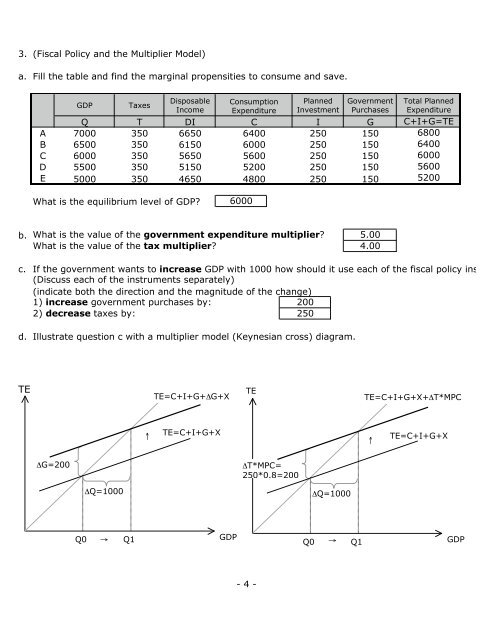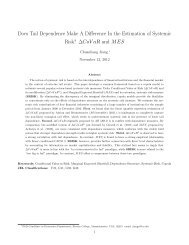Answer Key - Problem Set 3
Answer Key - Problem Set 3
Answer Key - Problem Set 3
You also want an ePaper? Increase the reach of your titles
YUMPU automatically turns print PDFs into web optimized ePapers that Google loves.
3. (Fiscal Policy and the Multiplier Model)<br />
a. Fill the table and find the marginal propensities to consume and save.<br />
A<br />
B<br />
C<br />
D<br />
E<br />
GDP Taxes<br />
Disposable Consumption Planned Government Total Planned<br />
Income Expenditure Investment Purchases Expenditure<br />
Q<br />
T DI<br />
C<br />
I<br />
G C+I+G=TE<br />
7000 350 6650 6400 250 150 6800<br />
6500 350 6150 6000 250 150 6400<br />
6000 350 5650 5600 250 150 6000<br />
5500 350 5150 5200 250 150 5600<br />
5000 350 4650 4800 250 150 5200<br />
What is the equilibrium level of GDP?<br />
6000<br />
b. What is the value of the government expenditure multiplier?<br />
What is the value of the tax multiplier?<br />
5.00<br />
4.00<br />
c.<br />
If the government wants to increase GDP with 1000 how should it use each of the fiscal policy instrum<br />
(Discuss each of the instruments separately)<br />
(indicate both the direction and the magnitude of the change)<br />
1) increase government purchases by:<br />
200<br />
2) decrease taxes by:<br />
250<br />
d. Illustrate question c with a multiplier model (<strong>Key</strong>nesian cross) diagram.<br />
TE<br />
TE=C+I+G+ΔG+X<br />
TE<br />
TE=C+I+G+X+ΔT*MPC<br />
↑<br />
TE=C+I+G+X<br />
↑<br />
TE=C+I+G+X<br />
ΔG=200<br />
ΔT*MPC=<br />
250*0.8=200<br />
ΔQ=1000<br />
ΔQ=1000<br />
Q0<br />
→<br />
Q1<br />
GDP<br />
Q0<br />
→<br />
Q1<br />
GDP<br />
- 4 -

















